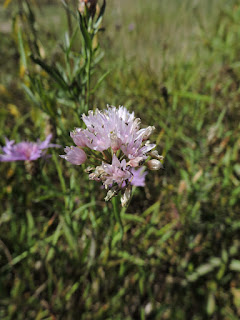Cerkniško jezero in western Slovenia is a great place, regardless of the season. Although September is already late for its most typical bird specialties (Scarlet Rosefinch, Barred Warbler, Corncrake, Red-necked Grebe ect.), there's still quite a lot to see. Yesterday me and a friend payed a visit to this site and the nearby Bloško polje. Weather-wise it was a great day of early autumn, with nice sunshine and a slight wind. Soon after arriving on site we already had a juvenile
Goshawk Accipiter gentilis spreding panic among the Great White Egrets
Casmerodius albus. A look at the sky and among the several Common Buzzards
Buteo buteo we were soon watching an immature
BLACK STORK Ciconia nigra, soaring above the wet grasslands. Later, while roving around the Cerknica lake, looking mostly for flowers, we also added to the list:
Hobby Falco subbuteo (3-4), Marsh Harrier
Circus aeruginosus (2-3), Wheatear
Oenanthe oenanthe, Yellowhammer
Emberiza citrinella, Whinchat
Saxicola rubetra,
Red-backed Shrike
Lanius collurio (2 juv), Green Sandpiper
Tringa ochropus (one of the few waterbirds seen), Yellow Wagtail
Motacilla flava, Spotted
Muscicapa striata and Pied Flycatcher
Ficedula hypoleuca and a few commoner birds. Along one of the forest roads we (twice) came across some Brown Bear's droppings.
 |
| Black Stork Ciconia nigra. A summer visitor to Cerkniško jezero, probably breeding somewhere in the forests around the lake. It is otherwise a rare species in Slovenia, with most of the breeding pairs concentrated in eastern Slovenia. This individual, being an immature is probably one of this year's juveniles born in the area. |
 |
| Gentiana pneumonanthe - a protected species in Slovenia which thrives on wet grasslands, bogs and heathlands and flowers later in the season. It is quite commonly found on some meadows around Cerkniško jezero and Bloško polje. |
 |
| Succisa pratensis - very abundant; forming "carpets" on the wet meadows. |
 |
| Colchicum autumnale - as the name says, an autumnal species, resembling a Crocus. Common on meadows and in woodlands at this time of year. |
 |
| Allium angulosum (what's left of it). Fairly common on wet grasslands, but yesterday most were already in seed. |
 |
| Viburnum opulus - a common bush at Cerkniško jezero, with very attractive, but poisonous berries. |
 |
| Droppings of Brown Bear Ursus arctos on the forest road near Cerkniško jezero. |
In the early afternoon we visited the nearby wet meadows and bogs of Bloško polje. This site is located east of Cerkniško jezero and is home to some rare and endangered plant and animal species (especially orchids, dragonflies, butterflies). The best time to visit is late spring (May/June), so yesterday we were a bit out of season. However we still managed to find a couple of interesting flowers and most interestingly, some Otter's droppings on a stone by the Bloščica stream. One or two Kingfishers
Alcedo atthis were a bit odd to see in an almost forest environment (at the edge of the wet meadows). Here we also heard a
Nutcracker Nucifraga caryocatactes, a few Bullfinches
Pyrrhula pyrrhula, Tree Pipts
Anthus trivialis and saw a Fieldfare
Turdus pilaris.
 |
| Bloško polje with mount Snežnik in the distance. |
 |
| One of the droppings of Otter Lutra lutra; containing pieces of crayfish's carapace and fish scales. Otter is found both on Bloško polje and on Cerkniško jezero (see here), although is very difficult to see. Its presence is usually detected by finding droppings which contain fish material and are found on exposed places by the streams and rivers in which it lives. |
 |
| Gentianella germanica |
 |
| Mentha aquatica - the wonderful smell of this plant is a constant presence while you walk on a wet meadow! |
 |
| The Bloščica stream is one of the few watercourses in Slovenia which still have a natural course. It flows through Bloško polje, creating scenic meanders and areas of wet meadows and bogs (increasingly rare and endangered habitats in Slovenia). |
 |
| Calopteryx virgo |
 |
| Sorbus aucuparia |
 |
| Bloško polje (with Velike Bloke's bell tower) and the Dinaric forests in the back. |
Later in the afternoon we returned to Cerkniško jezero for an evening session and awaited darkness by the (dry) lake. Here we heard a
Black
Dryocopus martius and a
Grey-headed Woodpecker Picus canus calling
from the forest, while Water Rails
Rallus aquaticus were calling from the reeds.
Later at dusk, an immature
WHITE-TAILED EAGLE Haliaeetus albicilla flew above our heads, heading to roost and represented (after the Black Stork) the second bird highlight of the day. Shortly afterwards a female Tawny Owl
Strix aluco called from the forest.
In the evening, we rounded up the day with a
WILDCAT Felis silvestris, crossing the forest road by the lake.
 |
| Roe Deer Capreolus capreolus (buck) at dusk. |
 |
| White-tailed Eagle Haliaeetus albicilla flies from Cerknica towards Otok, just after sunset. |


